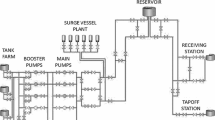Abstract
Nowadays, systems are becoming more and more complex. Therefore, modelling & simulation (M&S) are also growing in complexity. That’s why it is important to form, train and graduate students and faculty. The National Aeronautics and Space Administration (NASA) host an international event of M&S oriented in solving interoperability problems, Distributed Simulation (DS), and student cooperation. The goal is to use a DS standard: High Level Architecture (HLA) to simulate a moon base. Each team builds a module of it and have to communicate with each other. This context will be propitious for student to learn HLA programming, in order to reuse it in an industrial manufacturing context. The use of HLA is interesting in order to couple already existent heterogeneous works.
Access this chapter
Tax calculation will be finalised at checkout
Purchases are for personal use only
Similar content being viewed by others
References
Elfrey, P.R., Zacharewicz, G., Ni, M.: SMACKDOWN: adventures in simulation standards and interoperability. In: Proceedings of Winter Simulation Conference, pp. 3963–3967 (2011)
Falcone, A., Garro, A., Anagnostou, A., Chaudhry, N.R., Salah, O., Taylor, S.J.E.: Easing the Development of HLA Federates: The HLA Development Kit and Its Exploitation in the SEE Project, Distributed Simulation and Real Time Applications (DS-RT), pp. 50–57 (2015)
Gorecki, S., Zacharewicz, G., Perry, N.: Using High Level Architecture to Combine Simulations in Company Context Mobile Factory. International Multidisciplinary Modeling & Simulation Multiconference, Bordeaux (2017)
Zacharewicz, G., Labarthe, O., Chen, D., Vallespir, B.: Multi Agent/HLA Enterprise Interoperability (Short-Lived Ontology Based), The International Workshop on Modelling and Applied Simulation, Puerto de la Cruz, Spain, pp. 187–196 (2009)
IEEE Computer Society: IEEE Standard for Modeling and Simulation (M&S) High Level Architecture (HLA). Federate Interface Specification. IEEE Computer Society, USA, Available from standards.ieee.org (2010). Last accessed 1 June 2017
Zacharewicz, G., Chen, D., Vallespir, B.: Short-lived ontology approach for agent/HLA federated enterprise interoperability. Interoperab. Enterprise Softw. Appl. 329–335 (2009)
Lees, M., Logan, B.: Distributed simulation of agent-based systems with HLA. ACM Trans. Model. Comput. Simulat. TOMACS, 881–888 (2007)
Möller, B., Eriksson, S., Wihlborg, A.: Developing an HLA tutorial: philosophy and best practices. In: Proceedings of 2012 Fall Simulation Interoperability Workshop, Simulation Interoperability Standards Organization, 12F-SIW-047 (2012)
Acknowledgements
From a general point of view, this project brings much experience at the human level. Indeed, it has allowed us to work with major universities around the world. For that we would like to thank you NASA’s engineers for their support and the developers of the SEE Project providing all participants with a memorable, interactive, problem-solving experience which can contribute importantly to the workforce of the future.
Author information
Authors and Affiliations
Corresponding author
Editor information
Editors and Affiliations
Rights and permissions
Copyright information
© 2018 Springer International Publishing AG
About this chapter
Cite this chapter
Gorecki, S., Zacharewicz, G., Perry, N. (2018). Using High Level Architecture in the SEE Project for Industrial Context. In: Borangiu, T., Trentesaux, D., Thomas, A., Cardin, O. (eds) Service Orientation in Holonic and Multi-Agent Manufacturing. Studies in Computational Intelligence, vol 762. Springer, Cham. https://doi.org/10.1007/978-3-319-73751-5_21
Download citation
DOI: https://doi.org/10.1007/978-3-319-73751-5_21
Published:
Publisher Name: Springer, Cham
Print ISBN: 978-3-319-73750-8
Online ISBN: 978-3-319-73751-5
eBook Packages: EngineeringEngineering (R0)




